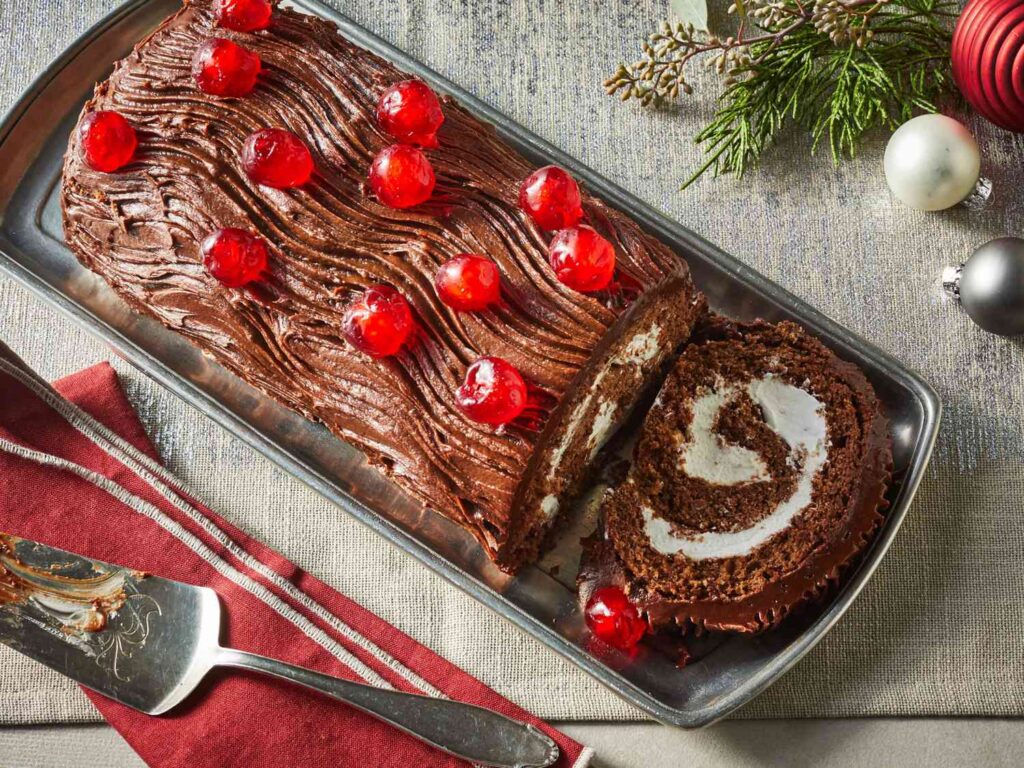Christmas is the time for celebration and throwing out diet through the window. And a celebration is never complete without something sweet in the end.

The time of the year has come when snowfall and cool breeze are what nature has to offer and delicious food, and extravagant decorations are what the humans have to offer. This is the time when everybody comes together to celebrate the joy of Christmas by sharing good food, having nice conversations, making a snowman or snow angels, and decorating their houses with lights and Christmas trees. The main attractions of Christmas are three things, the decorations, the food, and the presents under the tree. This blog will indulge you in the food section and what is a good Christmas dinner if there is no dessert. For decades, Christmas has claimed some of the dessert dishes as its own and is made only around this time of the year. So sit back and enjoy learning about these delicious, mouth-watering dishes. Having a sweet tooth might help you sit through the whole blog because it is going to be sweet, soft, chocolaty, sticky, gooey, crunchy, and a lot more.
Best Christmas Desserts
Christmas Yule Log
The practice of burning a log, thought to be Germanic in origin, was an ancient symbol of winter and a celebration of Winter Solstice, giving magical protection to the home and those who lived there. This tradition was adopted in countries of Christian faith, becoming historically prevalent in the UK, during the winter season known as Yuletide, from the old English word Yule, taken from various translations of Germanic, Old Norse, and Scandinavian languages. Hence, the joining of cultures and traditions in the name Yule Log. One of the favorite sweet treats of Christmas was first created in remembrance of an ancient tradition. The Christmas Chocolate Yule Log the world knows and loves actually represents the historical practice of collecting and burning a very large log in the hearth, throughout the Christmas season.
Made from a heavenly mix of light chocolate sponge, filled with chocolate cream and covered with a thick coating of chocolate buttercream icing, especially scrolled to resemble the patterns of tree bark, then often dusted with icing sugar for a snowy effect. Holly with berries and even little robins are common decorations for modern-day Yule Logs.
Christmas Crumble
A crumble (British English) or crisp (American English) is typically a dessert with a crumbly topping consisting of flour, butter, sugar, and sometimes oats, baked over a fruit filling. Apple and rhubarb are two popular varieties. Savory fillings such as meat, cheese, or vegetables may alternatively be used. As a dessert, crumbles are traditionally served with custard, cream, or ice cream. Expand your Christmas repertoire with this festive take on your favorite pudding. Use up left-over mincemeat – jarred or homemade – for extra flavor. The humble apple crumble is a comforting dessert that warms you from the inside out, especially on those chilly winter evenings. But this is not just any apple crumble; it is the Christmas crumble that you can give a twist over by infusing it with warm, nostalgic flavors of the holiday season. Imagine the familiar tang of apples, now enhanced with the zesty punch of orange, the aromatic warmth of cinnamon and clove, and a surprise splash of cranberry sauce that not only adds a tart contrast but also gives the crumble its beautiful, deep red hue.
Whether you’re looking to use up leftover cranberry sauce or just want to try something new, this Christmas Crumble is a must-try. Best served with a generous ladle of vanilla custard, because, let’s be honest, custard is the ultimate crumble companion.
Baileys ice cream
Baileys is an Irish cream liqueur made with cocoa, cream, and Irish whiskey. It has a rich chocolaty flavor with a sweet, vanilla kick. This holiday, you should try this ice cream and the money is on that you will love it. There are some reasons for that. It is so quick and easy – it takes less than 15 minutes to prep. It can be made ahead so it is an ideal Christmas dessert. It is perfect to serve as a lighter Christmas dessert or alongside Christmas pudding instead of brandy butter. It is full of flavor and texture thanks to the sweet condensed milk and Baileys liqueur, crunchy chocolate chunks, and creamy whipped cream. It is super versatile, you can switch up the chopped chocolate to use whatever you prefer – you could also play around with different liqueurs. It has no eggs so you don’t have to worry about serving homemade ice cream with partially cooked eggs to friends and family. This is an egg-free ice cream everyone can enjoy! It uses just 4 staple ingredients that you are likely to already have in your fridge and cupboards.
Gingerbread cupcakes
These moreish spiced cupcakes are great fun to make over the festive season for the whole family. Gingerbread houses have been for thousands of years and for many they remain a staple of the Christmas holiday tradition. Some families even turn making them into a competition with rules including that the house must be 100 percent edible and 75 percent gingerbread. The judges can be other family members or friends not competing, or the houses can be posted online for judging. Gingerbread houses are judged on their overall appearance, originality or creativity, how difficult it was to make, and the consistency of a theme. Gingerbread has been around for thousands of years. Ancient Greeks and Egyptians used gingerbread in religious ceremonies. Gingerbread was brought to Europe in 992 by an Armenian monk.
Through the 17th century, gingerbread was used for religious ceremonies. In the late 17th century, gingerbread became associated with Christmas. Gingerbread houses were introduced about 200 years later when the Grimm brothers wrote Hansel and Gretel. A new holiday tradition was born. People took the witches’ house and made it into a merry winter wonderland of cottage houses. The gingerbread Germans made was a harder consistency than more modern gingerbread, and people began using it to make their pretend houses. They could build taller and fancier houses. Gingerbread houses are adorned with gumdrops and other candies, along with confections. Because these cupcakes are so yummy, they disappear very quickly. Always a good sign when everyone in the family absolutely loves them.
Rum truffles
Rum balls were originally created as a way for Danish bakers to make use of cakes and pastries left over at the end of the day. They would mix them up with cocoa and rum, and roll the dough into balls, coating with coconut or chocolate sprinkles to sell for a low price the next day. Today, these truffle-like confections are popular throughout the world and made in a variety of flavors. They’re particularly popular for the holiday season. These rum balls contain two types of alcohol: bourbon and rum. The recipe makes six dozen rum balls, using 2/3 cup of alcohol, so it may not be enough for a serious buzz, but it is still present. If you’d prefer to make these rum balls with less alcohol, you can substitute a portion (or all) of the alcohol with orange or apple juice for a fruity touch, or try using water with a splash of rum extract or vanilla extract for a milder flavor.
Rum balls can be made well in advance of your holiday party, and the flavors will continue to develop over time. Refrigerate coated rum balls in an airtight container for up to one month, or freeze for up to three months. If frozen, thaw in the refrigerator at least two hours before serving. Rum balls are a popular Christmas treat in England, Australia, Canada, Germany, New Zealand, the United States, Austria, Slovenia, Hungary, Greece and the Czech Republic. In Denmark, they are enjoyed year-round and known as romkugle, trøffel, or sputnik, depending on the specific region.
Classic Christmas trifle
Want a Christmas trifle recipe with a boozy twist? This indulgent sherry trifle uses Amaretti biscuits for a lovely texture and flavor. It’s a perfect way to conclude your Christmas day meal. Trifles originated in 18th-century Britain and were designed to use up leftovers and stale cake. Pieces of the stale cake were soaked in alcohol and then stacked with fruit, custard, and sometimes jelly in a round bowl. Trifles and their iconic glass dishes came to America via the British who settled in the coastal South. The trifle became especially popular with Southerners who loved indulgent desserts. While its origins are British, the word trifle actually comes from the old French word trufe (or truffle), meaning something of little importance—an apt definition given how effortless a trifle dessert is to make. Today, a Southern holiday isn’t complete without at least one trifle, typically built from layers of cake (sometimes drizzled in syrup), custard, and fruit, topped with whipped cream in a glass bowl that shows off the stunning layers.
A trifle is a classic Southern dessert, especially around the holidays. It’s a great way to use up day-old cake or fresh fruit before it goes bad. They are a choose-your-own-dessert adventure where exact proportions aren’t always needed and ingredients can be endlessly swapped to create new flavors. (Just don’t go too wild—you don’t want to end up with something like Rachel Green’s infamous meaty Thanksgiving trifle from Friends.) So besides being an easy, flexible dessert, what is the definition of a traditional trifle? We answer your questions about ingredients, assembly, and how to give a trifle your own twist.
Stollen bites
Christmas Stollen also called a Christstollen in Germany, is a traditional pastry dating from the 14th century. Stollen loaves were made in Germany during the Christmas season to sell at fairs and festivals and to honor princes and church leaders. The term stollen comes from the Old High German word stollo, which means pillar. As the Catholic Church forbade the use of milk or butter during Lent (the five weeks of fasting leading up to Christmas), early stollen loaves were baked as bread without these 2 ingredients which made them less flavorful. During the middle of the 17th century, a papal decree allowed Stollen bakers to use milk and butter, the stollen we enjoy today.
There are many types of Stollen, like Dresdner Stollen, Mandelstollen, Quarkstollen, and Mohnstollen. Stollen also has religious symbolism, with the loaf of bread symbolizing Christ’s body. It represents the baby Jesus wrapped in swaddling garments by being coated with powdered sugar. As a result, it is also known as Christ Stollen or Christstollen.
Classic mince pie
Over the years, recipes have called for mutton, goose, and beef tongue. Even at the beginning of the 20th century, cooks relying on the popular Mrs. Beeton cookbook (published in 1861) included plenty of meat in their pies. Only in the last 50 years or so has suet stood in for meat, and only in the last decade has vegetarian suet become the default for commercially produced products. One of the oldest English cookbooks, The Forme of Cury (circa 1390) contains a recipe for a gloriously meaty mince pie. The ‘Tartes of Flesh’ contains stewed birds and rabbits, as well as ground-boiled pork. The mixture is flavored with cheese as well as ‘gode powdours and hool spices, sugur, and saffron.’ A recipe from Elinor Fettiplace’s Receipt Book (1609), suggests equal parts minced lamb, beef suet, currants, and raisins, and flavorings include ginger, mace nutmeg, cinnamon, orange peel, and sugar. Not a lot of sugar, however, as this was still the most expensive of luxuries. But as sugar became cheaper (with plentiful imports from the West Indies), mince pies became sweeter and recipes adapted to meet this new possibility.
In the brilliantly (but misogynistically) titled ‘The English Huswife, Containing the Inward and Outward Virtues Which Ought to Be in a Complete Woman’ (1615), written by Gervase Markham (a man, of course), there’s a recipe that describes mincing ‘the best flesh from the bone’ of mutton before flavoring the mixture with a range of spices that feels familiar to the canon today: clove, mace, pepper, and orange peel. In fact, these classic Spice Road flavors are what imbued mince pies with an almost mythical significance. Especially after the Crusades, when soldiers returned from Jerusalem having experienced tastes far beyond what they would have been used to in their English villages. You could even draw a connection to the journey of the Magi who followed a star from the East to bring gifts to the baby Jesus. Echoes of that connection still exist today; the stars on the pies.
Classic Christmas cake
People began using richer ingredients around the 16th century, and oats were swiftly supplanted by flour and eggs. This grew into a pudding, which eventually resembled the fruitcake we know today. To represent the three wise men, spices from the east were added to the cake. Richer households could also afford to coat their cakes in marzipan, giving them the appearance of today’s Christmas cake. While Christmas pudding was and continues to be a holiday staple, the baked cake, which originally contained yeast, was intended for Twelfth Night rather than Christmas. The cake has played an essential role in this feast day since at least the 16th century.
According to British culinary historians, the addition of marzipan and royal icing came much later, when a Christmas cake was forbidden because many Protestants throughout Europe were distrustful of Christmas celebrations in the 1600s. Twelfth Night is the final day of Christmas, and it used to be common to make an almond and marzipan-covered Twelfth Night cake. In the 1640s however, Oliver Crowell, Lord Protector of England, and other Puritans prohibited the celebration of Christmas (he also prohibited mince pies), stating that there was an excess. Because Christmas Day was still a public holiday with some feasting allowed, people simply made a Christmas cake and covered it in marzipan instead, and thus the Christmas cake was born.
Queen Victoria prohibited 12th-night celebrations on January 5th in the late 1800s since it was not a Christian event. Confectioners of the day lost revenue due to the loss of this feast day, so they remade the 12th night cake as a decorative iced cake for Christmas celebrations, and so the present-day Christmas cake was formed.
This may end here for the blog but in reality, it is far from ending. Apart from the delicious dishes mentioned above, there are a lot more for you to rummage through to find out the perfect one for you, your family, and the guest.

















